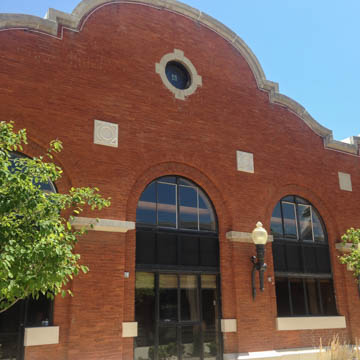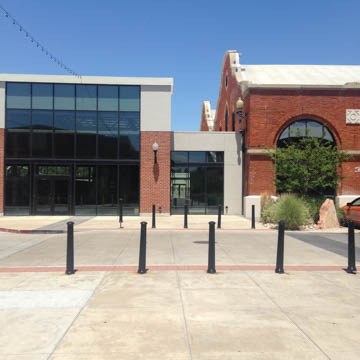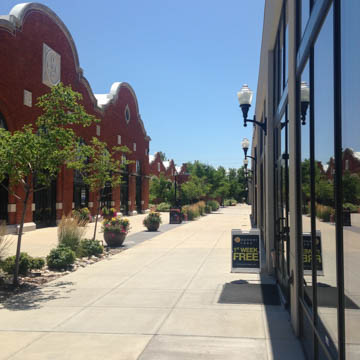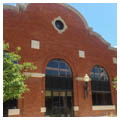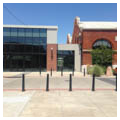The site now occupied by Trolley Square was originally a gathering place for Salt Lake City residents during county fairs and horse-trading sessions. Today, Trolley Square is an urban mall spread over an area of ten acres, serving as a model of adaptive reuse, urban revitalization, and historically sensitive urban development. It occupies a standard city block between Sixth and Seventh East, and Fifth and Sixth South. The Square includes seven buildings: the Utah Light and Railway Company built the original three structures in 1908, and four more were built a century later, in 2007–2008, adding 100,000 square feet of inhabitable space.
In the United States, the years between 1870 and 1914 witnessed the large-scale application of electric power and, concomitantly, the extension of the nation’s railroad network for cheap and efficient intercity and commuter transportation. In 1881, Salt Lake City became the fifth city in the world to develop and distribute electric power. Eight years later, in 1889, the Salt Lake City (SLC) Railroad Company installed electric streetcars, replacing mule-drawn cars with overhead power lines and cars with small wheels. As a local journalist described it at the time: “The car sped up grades in fine style, and people along the line stared as though an apparition were flying by.” By 1893, the SLC Railroad had grown from 9 to 42 miles of track with 63 trolley cars.
In 1906 railroad tycoon Edward H. Harriman, who had served as the chairman of the executive committee of the Union Pacific Railroad and the President of Southern Pacific Railroad, purchased SLC Railroad and the utility companies that powered it. His consolidated system included new lines that ran through downtown Salt Lake and into the rapidly expanding suburbs of Sugarhouse, Holladay, Bountiful, and Centerville. Harriman laid down 146 miles of track, with Trolley Square as the central storage and maintenance facility. He invested $3.5 million in the company and developed it into one of the most successful light rail systems in America, with over 144 cars by 1914. Trolley Square was not a transit hub for commuters but a store for rolling stock. Here tracks and machines were repaired and maintained, and a new steam power system was developed. The program was divided into four large buildings and numerous smaller buildings. The principal structures included the trolley barn, machine shop, sand house, and carpenter shop. In addition, a 97-foot-high water tower, with capacity for 50,000 gallons, was built for fire protection.
Trolley Barn is the largest of the buildings on the site. While it was planned as a utilitarian warehouse, its designers gave the exterior a monumental Mission Revival style treatment—then favored for railroad depots in American West. The barn’s five-bay shed measures 420 feet long and 300 feet wide. On the two shorter sides, four of these bays were spanned by two shallow arches each, springing from brick piers. The fifth one, added in 1914, had a broader, single arch. The band of the arch, plastered in light gray cement, creates a striking effect against the rest of the structure, which was finished in red brick. Originally the bays were divided with heavy brick walls serving as firewalls and the floor was divided by tracks. An elaborate metal space frame spanned the double-gabled roof of each bay. The space was lit by a gridded glass window and 208 skylights. The principal facades were decorated with baroque curves highlighting the slope of the gables.
Electric light rails dominated transportation in Greater Salt Lake until the late 1920s. In the coming decades, however, changes in the economy, the rise of the automobile, and new settlement patterns made Harriman’s Utah Light and Traction Company obsolete. On May 31, 1941, the company shut down. In 1945, the Trolley Square property became a bus depot. This changed reverberated throughout the city as trolley tracks and stops were destroyed and a whole new infrastructure of shared roads and bus stops was built. Though the bus system continues to function, in 1969 it left the Trolley Square location in the midst of citywide redevelopment.
The same year, real estate developer Wallace A. Walter, together with seven partners, bought Trolley Square and its buildings. In 1973, Walter hired Salt Lake architect Albert L. Christensen to repurpose Trolley Square into a shopping center of the type later known as a festival marketplace. The square’s transformation from a transportation maintenance center into a shopping mall coincides with middle-class urban flight and economic depression in Salt Lake City. Following the patterns established by Ghirardelli Square in San Francisco and Faneuil Hall in Boston, the Trolley Square conversion was intended to bring people back to the south end of the city.
With this conversion, the walls that separated the Trolley Barn’s bays were pulled down. A system of stairs, walks, and platforms was threaded throughout the complex. The height of the barn was divided into two floors. Steel piping railings around stairs and platforms maintained the memory of the transportation hub as they changed the section and plan of the barn. The interior was given a sense of continuity with the street by incorporating lampposts as the main source of artificial light.
Christensen also converted the 20,000-square-foot machine shop into a movie theater and a steakhouse, although today it is a generic retail space. The original sand house, used to store the sand that kept the trolleys from slipping on the tracks, became a drive-through bank in 1973. Because they were so much smaller in scale, these spaces did not require the dramatic space framing found in the trolley barn. Nonetheless, they share the barn’s exterior elements and contribute to the visual coherence of the complex.
In 2006, ScanlanKemperBard (SKB) bought the property. Over the following two years, SKB embarked on another major renovation and expansion project, adding new parking and shopping facilities, and demolishing the former sand house, whose historic properties had been compromised during the 1973 conversion. In 2007–2008, SKB revamped the property to accommodate car traffic, adding surface parking and four new structures that take their architectural cues from the three historic buildings on the site. The Whole Foods store, for example, projects the baroque curves of the 1908 parapets, albeit in glass. The bricks used by the new structures, however, are thicker and smoother, the grouting is cleaner, and the metal segments are more refined than their twentieth-century neighbors. SKB also moved the water tank a few feet to one side. Having become functionally redundant, it was adorned with a circular stair and decorated with illuminated signs. It now serves as a weather forecast tower and billboard that symbolically demarcates Trolley Square. The open spaces between the structures were divided between parking and pedestrian use. The intimate scale of these interstitial spaces have turned them into urban rooms.
Trolley Square offers visitors a history of different types of public transport in Salt Lake City—its appearance and disappearance, expansion and shrinkage—as well as a history of adaptive reuse in the area.
References
Hogan, Julia. If Trolley Cars Could Talk: Salt Lake City's Electric Streetcars and Trolley Square. Salt Lake City: Trolley Square Business Office, 1989.
Kidney, Walter C. Working Places: The Adaptive Use of Industrial Buildings: A Handbook Sponsored by the Society for Industrial Archaeology. Pittsburgh: Ober Park Associates, 1976.
Peters, Colleen Moore. Trolley Square. Salt Lake City: B. Dalton Ellers, 1982.
“Trolley Square: A Brief History.” Salt Lake Tribune, February 13, 2007.
Weinberg, Nathan. Preservation in American Towns and Cities. Boulder, CO: Westview, 1979.

